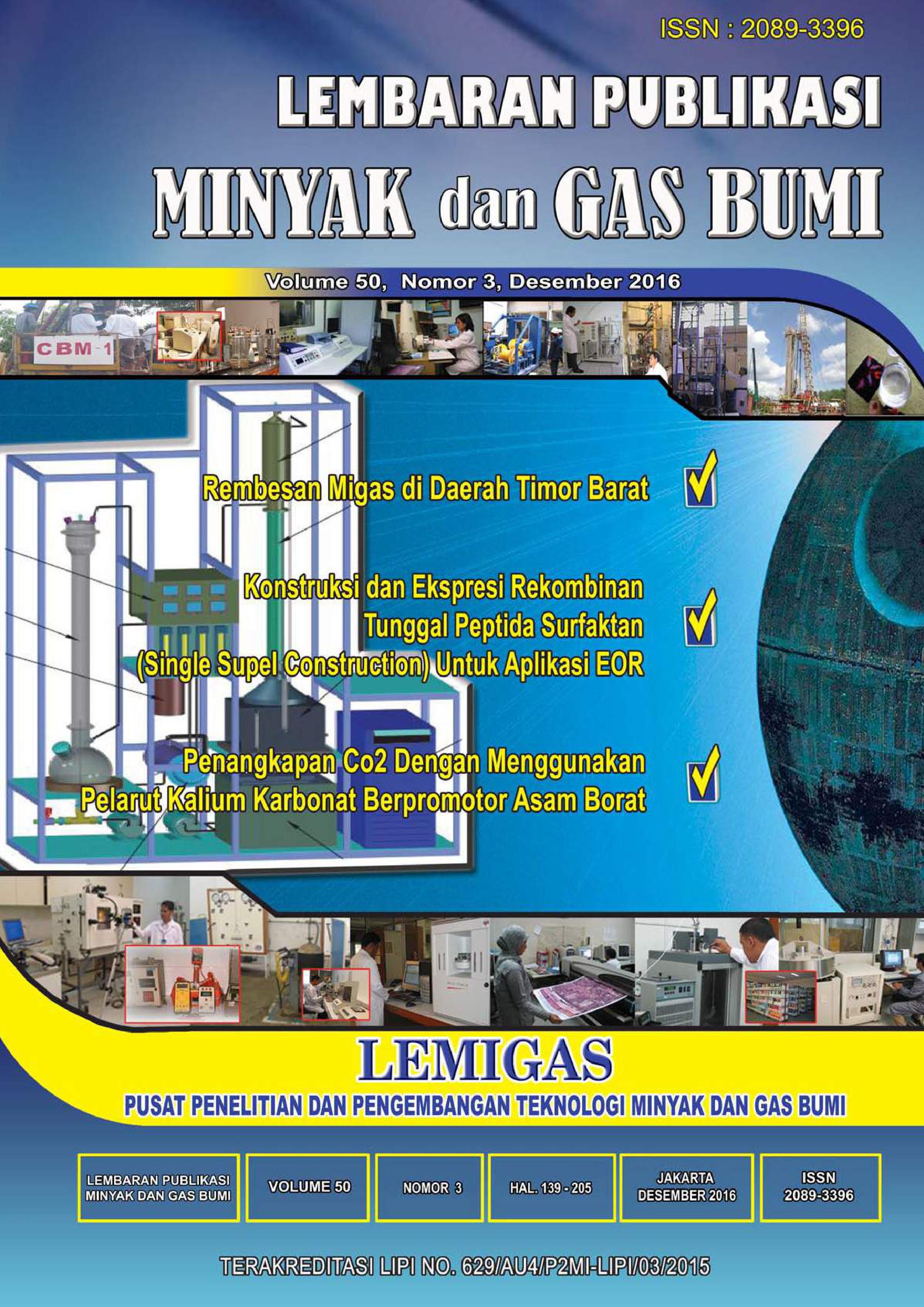PENANGKAPAN CO2 DENGAN MENGGUNAKAN PELARUT KALIUM KARBONAT BERPROMOTOR ASAM BORAT (CO2 Capture Using Potassium Carbonate solvent with Boric Acid Promoter)
DOI:
https://doi.org/10.29017/LPMGB.50.3.4Kata Kunci:
pelarut kalium karbonat, promotor asam borat, efisiensi penangkapan CO2. (Potassium Carbonate Solvent, Boric Acid Promoter, Capture CO2 Efficiency)Abstrak
Penangkapan CO2 dengan menggunakan pelarut kalium karbonat sampai saat ini masih terdapat kelemahan, yaitu laju reaksi yang lambat. Pada penelitian ini untuk mengatasinya maka digunakan promotor asam borat karena lebih ekonomis dan ramah lingkungan. Uji coba skala laboratorium dilakukan dengan sistem kontinu, yaitu dengan cara mengalirkan gas CO2 (20%) ke dalam pelarut K2CO3 (30%) berpromotor H3BO3 (3%) di dalam absorber pada suhu 50-70oC. Pelarut yang sudah mengandung CO2 akan dialirkan ke dalam desorber. Desorber dipanaskan hingga 70-90oC agar CO2 yang terabsorp di dalam pelarut dapat dilepaskan kembali. Pelarut K2CO3 akan masuk kembali ke dalam Tangki Pelarut untuk digunakan kembali dalam proses absorpsi CO2, dan seterusnya. Pada percobaan diukur konsentrasi gas CO2 yang masuk ke dalam absorber, yang keluar dari absorber, dan yang tidak terserap oleh absorber dengan menggunakan CO2 Analyzer. Sedangkan laju alir gas CO2 yang masuk ke dalam absorber dan yang keluar dari absorber diukur dengan menggunakan Flowmeter Digital. Konsentrasi pelarut juga diukur pada titik-titik yang sama dengan menggunakan metode titrasi. Laju alir pelarut yang masuk ke dalam absorber pada percobaan ini adalah konstan, sedangkan laju alir gas CO2 yang masuk ke dalam absorber divariasikan pada laju alir gas CO2 sebesar 1,25 liter/menit, 1,5 liter/menit, dan 2 liter/menit. Hasil terbaik dicapai pada laju alir gas CO2 sebesar 1,5 liter/menit dan diperoleh efisiensi penangkapan gas CO2 sebesar 87,63%.
CO2 capture using potassium carbonate solvent until now there are still weaknesses, namely the slow reaction rate. In this research, to overcome this weakness, boric acid promoter was used due to more economical and environmental friendly. Laboratory scale trial run was conducted with a continuous system, namely by bubbling CO2 (20%) into K2CO3 solution (30%) promoted by H3BO3 (3%) in the absorber at a temperature of 50-70oC. Solvent already containing CO2 would be transported into a desorber. The desorber was operated at temperature of 70-90oC causing the absorbed CO2 in the solvent can be released again. K2CO3 solvent will go back into the solvent tank for reuse in the process of absorption of CO2, and so on. In the experiment the concentration of CO2 that goes into absorber, which came out of the absorber, and that is not absorbed by the absorber were measured using a CO2 Analyzer. While the flow rate of CO2 gas that goes into and out of the absorber were measured using Digital Flowmeter. The concentration of the solvent is also measured at the same points using titration method. The flow rate of solvent into the absorber in the experiment are constant, while the flow rate of CO2 gas into the absorber was varied at a flow rate of 1.25 liters / min, 1.5 liters / minute, and 2 liters / minute , Best results are achieved in CO2 gas flow rate of 1.5 liters / minute and acquired CO2 capture efficiency of 87.63%.
Referensi
A. Raksajati, M.T. Ho, D.E. Wiley. 2013. “Reducing the cost of CO2 capture from flue gases using aqueous chemical absorption”. Industrial and Engineering Chemistry Research 52, 16887 – 16901.
Brett P. Spigarelli, S. Komar Kawatra. 2013. “Opportunities and challenges in carbon dioxide capture”. Journal of CO2 Utilization 1, 69–87.
D. Wappel, Khan Ash, David Shallcross, Sebastian Joswig, Sandra Kentish, Geoff Stevens. 2009. “The Effect of SO2 on CO2 Absorption in an aqueous potassium carbonate solvent”. Energy Procedia I, 125-131.
Guo, D., H. Thee, G. da Silva, J. Chen, W. Fei, S. Kentish, G. W. Stevens. 2011. Borate-catalyzed Carbon Dioxide Hydration via The Carbonic Anhydrase Menchanism. Environmental Science & Technology 45.
Indonesia CCS Study Working Group. 2009. Understanding Carbon Capture and Storage Potential in Indonesia.
IPCC’s Fifth Assessment Report, 2014
Karube, I., Takeuchi, T., Bares, D.J. 1992. Biotechnological Reduction of CO2 Emission, Advances in Viochemical Engineering/Biotechnology, 46, 63-79.
Kentish, S., 2010. Capture Technologies: Solvents. Cooperative Research Centre for Greenhouse Gas Technologies (CO2CRC). Brisbane. Australia.
Kentish, S, H. Thee, K.H. Smith, G. da Silva, G.W. Stevens. 2011. Carbon dioxide absorption into unpromoted and borate-catalyzed potassium carbonate solutions. Chemical Engineering Journal 181-182, 694-701.
Kentish, S., K.H. Smith, C.J. Anderson, W. Tao, K. Endo, k.A. Mumford, A. Qader, B. Hooper, G.W. Stevens. 2012. Pre-combustion capture of CO2-Results from solvent absorption pilot plant trials using 30 wt% potassium carbonate and boric acid promoted potassium carbonate solvent. International Journal of Greenhouse Gas Control 10 (2012) 64-73.
Pangastuti, A. (2011). Model absorpsi gas CO2 dalam larutan K2CO3 dengan promotor asam borat pada packed column. Undergraduate Thesis, Chemical Engineering, RSK 660. 284 23 Pan. Surabaya
Pusdatin. 2006. Buku Pegangan Statistik Ekonomi Energi Indonesia. DESDM
Rackley,S.A. 2010. Carbon Capture Storage. Elsevier Inc.
Rochelle, G.T., et al. 2007. “CO2 Capture by Absorption with Potassium carbonate”. Final Report Department of Chemical Engineering The University of Texas at Austin and the University of Regina, Saskatchewan. USA.
U.S. Environmental Protection Agency. 2010. Available And Emerging Technologies ForReducing Greenhouse Gas Emissions FromThe Petroleum Refining Industri.Sector Policies and Programs DivisionOffice of Air Quality Planning and StandardsU.S. Environmental Protection AgencyResearch Triangle Park, North Carolina.
United States Patent no 3.907.969. 1975. Separation of CO2 From GasMixtures.











